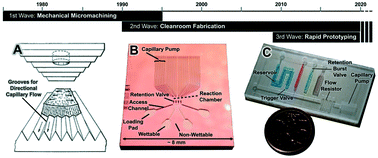Our official English website, www.x-mol.net, welcomes your feedback! (Note: you will need to create a separate account there.)
Capillary microfluidics in microchannels: from microfluidic networks to capillaric circuits†
Lab on a Chip ( IF 6.1 ) Pub Date : 2018-07-16 00:00:00 , DOI: 10.1039/c8lc00458g Ayokunle Olanrewaju 1, 2, 3, 4 , Maïwenn Beaugrand 1, 2, 3, 4 , Mohamed Yafia 1, 2, 3, 4 , David Juncker 1, 2, 3, 4
Lab on a Chip ( IF 6.1 ) Pub Date : 2018-07-16 00:00:00 , DOI: 10.1039/c8lc00458g Ayokunle Olanrewaju 1, 2, 3, 4 , Maïwenn Beaugrand 1, 2, 3, 4 , Mohamed Yafia 1, 2, 3, 4 , David Juncker 1, 2, 3, 4
Affiliation

|
Microfluidics offer economy of reagents, rapid liquid delivery, and potential for automation of many reactions, but often require peripheral equipment for flow control. Capillary microfluidics can deliver liquids in a pre-programmed manner without peripheral equipment by exploiting surface tension effects encoded by the geometry and surface chemistry of a microchannel. Here, we review the history and progress of microchannel-based capillary microfluidics spanning over three decades. To both reflect recent experimental and conceptual progress, and distinguish from paper-based capillary microfluidics, we adopt the more recent terminology of capillaric circuits (CCs). We identify three distinct waves of development driven by microfabrication technologies starting with early implementations in industry using machining and lamination, followed by development in the context of micro total analysis systems (μTAS) and lab-on-a-chip devices using cleanroom microfabrication, and finally a third wave that arose with advances in rapid prototyping technologies. We discuss the basic physical laws governing capillary flow, deconstruct CCs into basic circuit elements including capillary pumps, stop valves, trigger valves, retention valves, and so on, and describe their operating principle and limitations. We discuss applications of CCs starting with the most common usage in automating liquid delivery steps for immunoassays, and highlight emerging applications such as DNA analysis. Finally, we highlight recent developments in rapid prototyping of CCs and the benefits offered including speed, low cost, and greater degrees of freedom in CC design. The combination of better analytical models and lower entry barriers (thanks to advances in rapid manufacturing) make CCs both a fertile research area and an increasingly capable technology for user-friendly and high-performance laboratory and diagnostic tests.
中文翻译:

微通道中的毛细管微流体:从微流体网络到毛细管回路†
微流体技术可节省试剂的成本,加快液体输送速度,并具有实现许多反应自动化的潜力,但通常需要外围设备来进行流量控制。通过利用微通道的几何形状和表面化学性质所编码的表面张力效应,毛细管微流体可以以预编程的方式输送液体,而无需外围设备。在这里,我们回顾基于微通道的历史和进展毛细管微流控技术跨越了三十年。为了既反映了最近的实验和概念进展,又与基于纸的毛细管微流体相区别,我们采用了较新的毛细管回路(CCs)术语。我们确定了由微细加工技术驱动的三个不同的发展浪潮,首先是在工业中采用机加工和层压的早期实施方案,然后是在使用微细全分析系统(μTAS)和使用无尘室微细加工的芯片实验室设备的背景下进行的开发,以及最终,随着快速原型技术的发展,出现了第三次浪潮。我们讨论了控制毛细管流动的基本物理定律,将CC分解为基本回路元素,包括毛细管泵,截止阀,触发阀,保持阀等,并描述其工作原理和局限性。我们将讨论在自动进行免疫测定的液体输送步骤中最常用的CC的应用,并重点介绍诸如DNA分析之类的新兴应用。最后,我们重点介绍了CC快速原型开发的最新进展以及所提供的好处,包括CC设计的速度,低成本和更大的自由度。更好的分析模型和更低的进入壁垒(由于快速制造的进步)的结合,使CC既是肥沃的研究领域,又是功能强大的技术,可用于用户友好的高性能实验室和诊断测试。最后,我们重点介绍了CC快速原型开发的最新进展以及所提供的好处,包括CC设计的速度,低成本和更大的自由度。更好的分析模型和更低的进入壁垒(由于快速制造的进步)的结合,使CC既是肥沃的研究领域,又是功能强大的技术,可用于用户友好的高性能实验室和诊断测试。最后,我们重点介绍了CC快速原型开发的最新进展以及所提供的好处,包括CC设计的速度,低成本和更大的自由度。更好的分析模型和更低的进入壁垒(由于快速制造的进步)的结合,使CC既是肥沃的研究领域,又是功能强大的技术,可用于用户友好的高性能实验室和诊断测试。
更新日期:2018-07-16
中文翻译:

微通道中的毛细管微流体:从微流体网络到毛细管回路†
微流体技术可节省试剂的成本,加快液体输送速度,并具有实现许多反应自动化的潜力,但通常需要外围设备来进行流量控制。通过利用微通道的几何形状和表面化学性质所编码的表面张力效应,毛细管微流体可以以预编程的方式输送液体,而无需外围设备。在这里,我们回顾基于微通道的历史和进展毛细管微流控技术跨越了三十年。为了既反映了最近的实验和概念进展,又与基于纸的毛细管微流体相区别,我们采用了较新的毛细管回路(CCs)术语。我们确定了由微细加工技术驱动的三个不同的发展浪潮,首先是在工业中采用机加工和层压的早期实施方案,然后是在使用微细全分析系统(μTAS)和使用无尘室微细加工的芯片实验室设备的背景下进行的开发,以及最终,随着快速原型技术的发展,出现了第三次浪潮。我们讨论了控制毛细管流动的基本物理定律,将CC分解为基本回路元素,包括毛细管泵,截止阀,触发阀,保持阀等,并描述其工作原理和局限性。我们将讨论在自动进行免疫测定的液体输送步骤中最常用的CC的应用,并重点介绍诸如DNA分析之类的新兴应用。最后,我们重点介绍了CC快速原型开发的最新进展以及所提供的好处,包括CC设计的速度,低成本和更大的自由度。更好的分析模型和更低的进入壁垒(由于快速制造的进步)的结合,使CC既是肥沃的研究领域,又是功能强大的技术,可用于用户友好的高性能实验室和诊断测试。最后,我们重点介绍了CC快速原型开发的最新进展以及所提供的好处,包括CC设计的速度,低成本和更大的自由度。更好的分析模型和更低的进入壁垒(由于快速制造的进步)的结合,使CC既是肥沃的研究领域,又是功能强大的技术,可用于用户友好的高性能实验室和诊断测试。最后,我们重点介绍了CC快速原型开发的最新进展以及所提供的好处,包括CC设计的速度,低成本和更大的自由度。更好的分析模型和更低的进入壁垒(由于快速制造的进步)的结合,使CC既是肥沃的研究领域,又是功能强大的技术,可用于用户友好的高性能实验室和诊断测试。



























 京公网安备 11010802027423号
京公网安备 11010802027423号